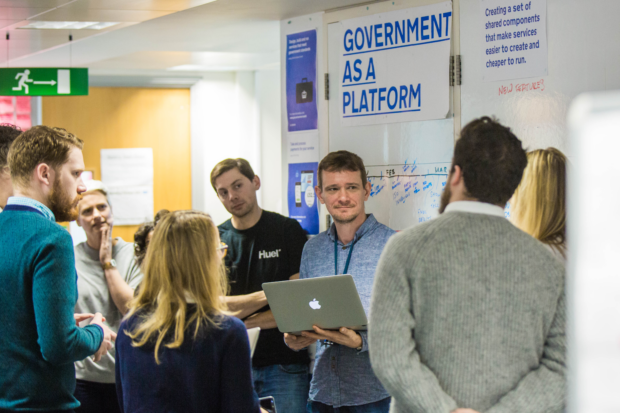As more services begin to adopt Government as a Platform components, we’ll publish regular updates here on this blog. We’ll blog about our progress developing these components, and our work to support service teams across government as they integrate with, and use, them.
We’ll iterate the format of these regular updates - in this one we’ll focus on some of those components and patterns.

Components, patterns and guidance
Government as a Platform is here to help departments and agencies solve common problems once. By providing a variety of shared components, patterns and guidance we free service teams up, and make it easier for them, to focus on designing, assembling and iterating services.
Before we tell you what we’ve been working on specifically, here’s a reminder of what those components and patterns are.
Digital Communications
We’re creating a set of digital communications tools to make it easier for government to contact users proactively and reduce the rate and cost of contact to government. These include:
GOV.UK Notify which makes it easier to keep people updated, by helping service teams across government to send text messages and emails to their users. Notify is now available to all of central government. It’s self-service, so visit www.gov.uk/notify to find out more and try it out.
The Letters discovery explores simpler, faster and cheaper ways of sending letters to people who use public services. Get in contact with the team to find out more about reducing the cost of sending letters.
Webchat service patterns help departments evaluate, procure and implement webchat systems more quickly. Get in contact with the team to find out more about the alpha findings.
GOV.UK Pay
This is a simple, secure way for people to pay for government services online. It will make it easier and more efficient for government to process payments, saving time and effort for service teams across government. Find out more about GOV.UK Pay.
GOV.UK Platform as a Service
The GOV.UK Platform as a Service (PaaS) hosts a range of digital services, so teams don’t have to build and manage complex infrastructure themselves. Find out more about GOV.UK Platform as a Service.
Accessing GaaP services
To do their jobs, Civil Servants often need multiple accounts with usernames and passwords, to access internet-hosted services. This alpha explores how to stop the proliferation of user accounts and to simplify how how accounts are managed. The team are also investigating how to make it easier to authenticate staff.
Registers
We’re working with several government departments and agencies to develop their registers, which are lists of information. Each is the most reliable list of its kind. For service teams, using a register will mean only ever working with one reliable and current source of data. Find out more about registers.
In the last month we’ve:
1. Improved and iterated GaaP components
To iterate and improve components to ensure they meet the needs of citizens and service teams, and maximise efficiency for government, we’ve:
- carried out some necessary health checks to GOV.UK Notify and built in some auto failover measures
- upgraded the GOV.UK Notify API to version 2
- worked with the Accessibility team on an audit for GOV.UK Notify as they prepared to go into public beta
- added functionality to allow beta partners, and future adopters of GOV.UK Pay, to batch payments together
- been making improvements to security on GOV.UK Pay by incorporating 3D Secure (an anti-fraud measure) into the payment process
- improved technical documentation for the PaaS using the new technical documentation format - this was based on user research
- made changes to the register homepages based on user feedback
- tested a new iteration of the country picker using the country and territory registers, and as part of this process we created a reusable typeahead
- been mapping user journeys to simplify how users find what they need to use a register
- been testing the Accessing GaaP Services alpha with Cabinet Office staff and Crown Commercial Service users in Norwich
2. Supported the adoption of GaaP components
To support the adoption of components across central government departments and agencies, we’ve:
- made GOV.UK Notify open to all central government departments after it passed its public beta service assessment
- setup a service dashboard page, which shows 32 services are now using GOV.UK Notify
- set up a service dashboard for GOV.UK Pay
- published a roundup of webchat user research, services patterns, insight and recommendations
- had a public beta service assessment for GOV.UK Notify
- set up additional support for one of our payment providers on GOV.UK Pay
- received official approval for GOV.UK PaaS to hold personal and confidential data
- been preparing to onboard our second and third services to the PaaS - GOV.UK Notify and Digital Marketplace
- been finalising an out-of-hours support plan to give operational and technical support 24 hours a day, 7 days a week to services hosted on the PaaS
- worked with Service Manual teams to publish the service toolkit with standards, patterns and components to use, build and run services that meet government standards
- published product pages for each of the GaaP components (for example the GOV.UK Pay product page) as part of the service toolkit
Follow Ben on Twitter and don’t forget to sign up to email alerts